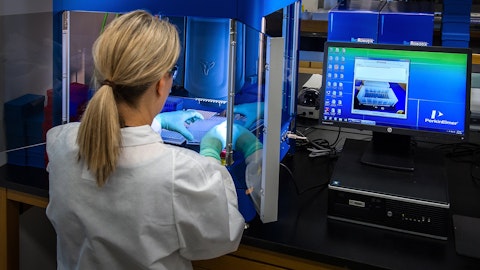Craig McKasson: Yes. So first of all, relative to market dynamics, just to clarify, I wasn’t being specific to Contigo, I was talking about the Performance Services segment overall. I will say broadly that I think that the strategic alternative view has certainly had customers at certain points across all of our businesses kind of have questions about what the future holds. And so as we did indicate in our remarks, we are excited now having that behind us and being able to go out and have conversations with customers about the business moving forward. Relative to Contigo and S2S, we’re also excited about the opportunity to talk about what the future potential is with a very strong partner alongside us to actually take those businesses with more expertise and resources to the next level.
So we do feel good about what the future may be relative to that. As far as free cash flow conversion, at this point, given that those are still included in our guidance, that is the perspective that we’re providing in terms of free cash flow conversion. To the extent that we get to a place that we would actually put those as held for sale and need to update our guidance further into fiscal 2024. We would certainly provide a revised perspective on the conversion of the EBITDA we would have at that point in time. But overall, we would expect slight improvement given some of the working capital requirements in the S2S business.
Allen Lutz: Great. Thank you.
Michael Alkire: Thank you.
Operator: The next question comes from Eric Coldwell of Baird. Please go ahead.
Eric Coldwell: Thanks. I have three questions. First one on the remaining $600 million of repo post ASR. What determines if and when or how likely you’d be in the market? And would you anticipate any open market activity before the ASR completes? Or typically, we think of companies getting through that process before getting back to the market. I’m just curious on determinations of if and when and then potential timing for the next round?
Craig McKasson: Sure. Thanks, Eric. This is Craig. So first of all, we do not expect to be in the market while the accelerated share repurchase. The first $400 million is taking place. So your perspective is correct on that. We’ll let the $400 million take place. We do anticipate that likely could take us through and complete in the first quarter of fiscal 2025. So I think that when — the thinking is that when we come out and provide our fourth quarter earnings release in August would be the time that we would provide an update relative to expectations at that time for the remaining $600 million and a determination at that point, again, based on capital needs, market conditions, all the things that we’ll have to see ongoing trading volume once we’ve taken the $400 million out, et cetera — how we might and if we would implement a further share repurchase at that point.
And I think that, that would likely either be through open market or potentially another accelerated share repurchase, but that is to be determined at that time.
Eric Coldwell: Thanks. Thanks, Craig. Next question is on the direct sourcing product business. With the partnerships on gowns and gloves be included in this consideration of finding a partner? Or would those be held independently? Or is that TBD.
Craig McKasson: Generally, I would say, obviously, it does depend based on the nature of the negotiations we will likely have with certain partners. But by definition, today, Eric, those are independent — and so there is not a requirement that the domestic manufacturing partnerships that we have for gowns and certainly for generic drugs and for mass would go into the transaction.
Eric Coldwell: Okay. And then sourcing profitability. I know that business is very determined by the gross margin performance, and you did mention gross margin perked up. Revenue, obviously, has been a bit more challenged — typically think of that business is hovering in the low to mid-single-digit EBITDA range. Was it in that ZIP code during 2Q?
Craig McKasson: Low-single-digit — that’s correct.
Eric Coldwell: Yes. Okay. And then last one, maybe I have four actually. This is the most complex so bear with me. If I’ve done the math correctly on Contigo, it looks like it did $40 million, $41 million of revenue last year. You’re targeting about 40%, maybe a tad over $40 million this year. So Contigo is flat. Yet adjacent markets, given the near 30% first half growth to get to 20% for the full year has to be around 10% in the second half on average per quarter. So that’s about a $10 million quarterly decrease on average if — again, if I’ve done this right. My question is, is the second half reduction in adjacent market revenue because Contigo was higher in the first half and now lower in the second half? Is it because ELAs, your enterprise license agreements are much lower in the second half than they were in the first half, even though was down quarter-over-quarter.
Is it those things in a combination of other items? I’m just trying to get a sense on why adjacent markets growth and absolute dollars are here lower here in the second half?
Craig McKasson: Yes. There’s a lot to unpack there, Eric. So I need to process that a little bit, but probably.
Eric Coldwell: Yes, probably to be fair, that’s a long question.
Craig McKasson: But generally, at a broad level, what I would say is we don’t expect a significant step back in adjacent markets. First of all, your commentary around Contigo is accurate in terms of sort of the levels of performance based on my commentary. We don’t expect a significant step back in adjacent markets in the back half of the year. I will say we had a strong first half, particularly with our applied sciences business in the second quarter. So it’s not growing at the clip that it might have on a normal basis, but it’s not stepping back at that level. We are seeing, as I mentioned in my commentary around Performance Services we’re not being as aggressive quite candidly on enterprise licenses and the level of conversion that we’re going to see on those in the second half of the year from an overall cadence standpoint for this segment.
Eric Coldwell: Okay. Thanks very much for all the questions. I appreciate it, Craig.
Craig McKasson: Thanks, Eric.
Operator: The next question comes from Jessica Tassan of Piper Sandler. Please go ahead.
Jessica Tassan: Hi. Thank you guys for the questions and congratulations on the end of the review. I was hoping you could just remind us what is the share back rate expected to be in the health care GPO exiting FY’24? And then in FY’25, would you guys expect to be kind of in line with the market for the full year such that competitive takeaways or new customer adds could potentially accelerate?
Craig McKasson: Sure, Jessica. This is Craig. So as we indicated in my remarks, we expect the fee share rate across the GPO to be in the mid-50% range for fiscal 2024. We aren’t providing perspectives yet on fiscal 2025 or moving forward. But as we have said publicly to the extent that the market dynamics that we’ve been experiencing continue. If we do see further consolidation in the marketplace, which has affected it at times, we could see pressure and increase in administrative fee share above that mid-50% level. But until we have better visibility to that as we get into our planning for fiscal 2025. At this point, we’re not providing specific guidance about where we expect that to be.
Jessica Tassan: Got it. That’s helpful and fair I think. So my next question is just I don’t mean to harp on this one, but just hoping to understand what led you guys to conclude that Contigo is noncore. And just interested kind of in timing, did that decision occur towards the end of the strategic review? Wondering just why it was impossible to execute on a partnership or potentially a sale earlier in the review process.
Michael Alkire: Jessica, this is Mike. So obviously, there were a lot of conversations that were happening in the strategic review process. I will tell you there’s a number of reasons why we decided to announce the Contigo potential looking for potential partners. I think the number one was that I think as the process continues to evolve. It just became more apparent to us that there was a lot of interest in that asset. And obviously, we believe that we would like to find a partner that collectively with us can take that capability to a much different higher level. to help our health care systems as they’re moving more towards that sort of pay wider space. So I would just tell you that it was a little bit of timing, but there was a lot going on in that process. And it I think the team and the board just felt it was really time to move out of the strategic evaluation process.
Jessica Tassan: Okay. Got it. That’s helpful. And then my last question is just, obviously, hospital operating margins ended 2023 strong and seems like momentum is accelerating. Just hoping for kind of an updated perspective on where Premier expects to participate in that strength? And over what time frame is there a lag that we should be anticipating. Thank you guys.
Michael Alkire: Thank you. So a couple of things. First of all, at the end of the calendar year, we saw inpatient volumes going up 1.4% and outpatient volumes going up 1.6%. So that was the last quarter of the calendar year. So as you’d expect, that obviously is a bit of a tailwind, obviously, for our supply chain capabilities. Having said that, there are three significant issues that are affecting health care right now. One is the continual labor issue. And we think we’re incredibly well positioned to deal with the labor issues. So if you think about our technologies to help our health care systems use labor efficiently. If you think about our AI and machine learning capabilities that can help our health care systems move processes that have been manual to more technology enabled.




